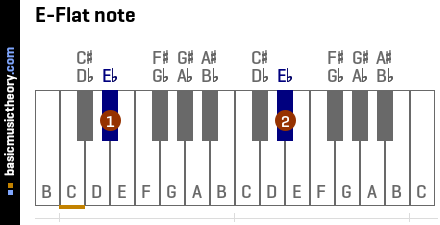Note name
| Note name | C | C# | Db | D | D# | Eb | E | E# | Fb | F | F# | Gb | G | G# | Ab | A | A# | Bb | B | B# | Cb |
|---|
The example on the piano diagram below shows the Eb note highlighted.

Black note names
From the piano diagram above, you can see that all black notes have two possible names - a sharp and a flat name.
The choice as to whether a black note takes the sharp or flat name depends on the scale or chord being constructed that uses that note.
For example, the black key highlighted above is called note Eb when used in the Db major scale but is called D# when used in the B major scale scale.
But crucially, these two notes sound the same - it is just the note names that are different.
In music theory, it is said that these two note names are enharmonic to each other.
Natural white note names
The white notes are shown with a single note name from A to G, with no sharp or flat signs. They are called natural when they do not have to be sharpened, or flattened when constructing a scale or chord.
Sharp and flat white note names
Be aware that white notes can also have sharp or flat names.
For example, white note C, when flattened, becomes note Cb, which has the same pitch, and is actually note B that is being played on the piano.
Again, depending on the scale being constructed in a particular key, either name could be used.
For example, note name B is used when constructing the D major scale, but this pitch / sound is called Cb when used to construct the Gb major scale.
In the same way, when note E is sharpened for use in a scale, it is called E# which occupies the F white note position.
Or when note F is flattened, it is called Fb which occupies the E white note position.
Finally, when note B is sharpened, it is called B# which occupies the C white note position.
Double accidentals
When constructing scales, it is theoretically possible for a note name to have a double sharp, that is adjusted by 2 half-tones / semitones / piano keys up or down.
For example, the D# major scale scale contains 2 double-sharps, and the A# major scale contains 3.
However, both of the scales are rarely used and are difficult to work with, so the scales Eb major scale and Bb major scale are often used in their place, which contain the same note pitches as the other scales. ie. the scales are enharmonic.
Given a pair of enharmonic scales with identical pitches, it makes sense to use the scale that has the fewest sharps and flats.
Triple accidentals
When constructing chords, it is even possible for a note name to have a triple accidental, that are adjusted by 3 half-tones / semitones / piano keys up or down.
For example, the B# augmented chord contains a triple sharp, but again, this chord is difficult to work with, so the enharmonic equivalent - C augmented chord is often used instead.